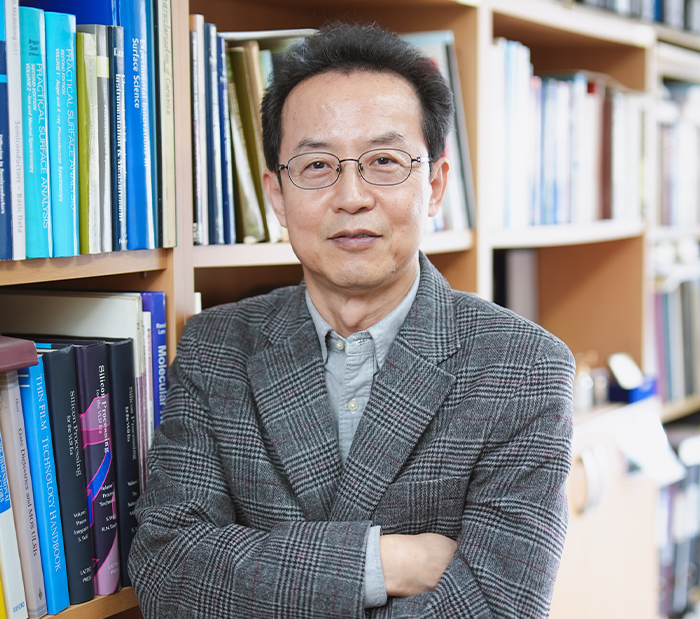Predicting and demonstrating of hidden metastable phase in transition metal oxide
Advanced Materials Science and Engineering LEE, JAICHAN Prof. · Bongwook Chung

-
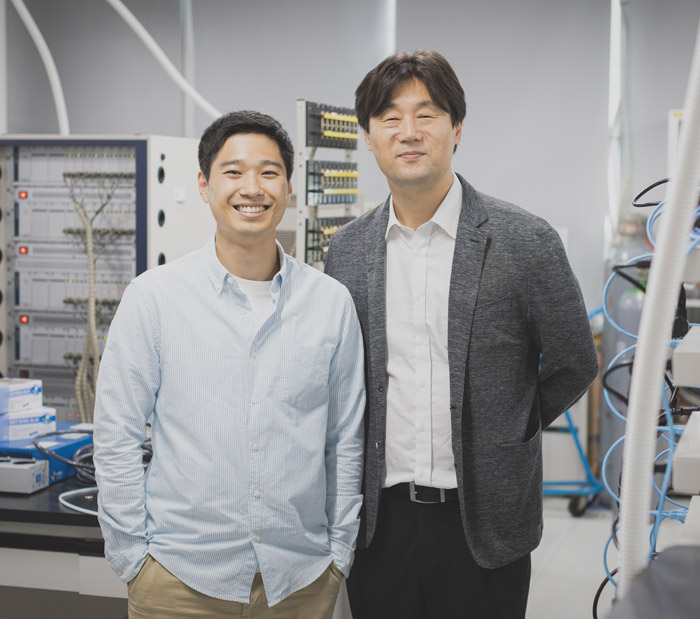
Energy Science YOON, WON SUB Prof. ·Researcher Eunkang Lee
Provides a new way to develop cathode materials for longer and safer vehicle batteries
Prof. Won-Sub Yoon’s research team successfully derives the key factors on the thermal instability of Ni-rich cathode material for lithium-ion batteries. This research work was published in the Advanced Science (IF: 15.804) on April 24 as a back cover, with the title "Tracking the Influence of Thermal Expansion and Oxygen Vacancies on the Thermal Stability of Ni‐Rich Layered Cathode Materials." The extensive demand for high energy storage in electric devices, electric vehicles and smart grid systems has led to the commercialization of rechargeable lithium ion batteries using Ni-rich layered cathode material. Simultaneously, the safety issue from the thermal instability of Ni-rich cathode materials has been introduced. Until now, the strategy to enhance its thermal stability has been approached based on fragmentary facts that the thermal instability is merely attributed to the thermally unstable Ni element. However, these approaches have limitations in providing a custom solution to the fundamental cause of thermal instability involving Ni element. Prof. Won-Sub Yoon's research team showed that the thermal expansion of Li slab become larger as the increase of Ni content in the cathode material before the onset temperature of layered to disordered spinel phase transition is reached. This thermal expansion of Li slab induces the elongation of intermediate tetrahedron in pathway of cation migration, resulting in an expanded pathway with a low energy barrier for cation migration. In addition, the oxygen vacancies are formed and accumulate around only Ni ions before the onset temperature of phase transition is reached. In presence of oxygen vacancies, the cation migration pathway is energetically mitigated as Ni ion migrates through the face-shared oxygen plane that does not contain oxygen vacancies. Herein, the team proposed the thermal expansion and oxygen vacancies as new critical factors to affect thermal stability of charged Ni-rich cathode materials as shown in the figure below. [Figure 1] Occurrence of thermal expansion and oxygen vacancies in Ni-rich layered cathode materials due to increase of temperature and the process of change in the crystal structure and phase transition ※ Title: Tracking the Influence of Thermal Expansion and Oxygen Vacancies on the Thermal Stability of Ni‐Rich Layered Cathode Materials ※ Original Article URL: https://onlinelibrary.wiley.com/doi/full/10.1002/advs.201902413
- No. 138
- 2020-07-06
- 3974
-

Mechanical Engineering KIM, JAEHOON Prof. ·Researcher Handi Setiadi Cahyadi
Revealing the Intercalation Mechanisms of Lithium, Sodium, and Potassium in Hard Carbon
Revealing the Intercalation Mechanisms of Lithium, Sodium, and Potassium in Hard Carbon Due to its high stability, widespread availability, low-cost, and excellent performance, hard carbon is considered as one of the most promising anode materials for sodium and potassium-ion batteries. To further develop a high-performance electrode, it requires a deep understanding of the carrier-ion storage mechanism. However, this has proven to be not such a trivial task because of the complex structure of hard carbon. Recent work by Prof. Kim and his team unveil that the sloping voltage region is caused by the adsorption of Li-ion, Na-ion, and K-ion on the surface of active sites such as defects, edges, and residual heteroatoms. Afterward, the carrier-ions penetrate into the graphitic layers, creating a low voltage plateau region. This finding also further proven by DFT simulation, which revealed the change in the inner molecular structure of the hard carbon during the discharge process. The “ripening” phenomenon, in which the edge of the hard carbon structure open up when the carrier ion approach to the edge of graphitic layer, is very prevalent for the Na-ion and K-ion because of their larger electronic radius. However, the same degree of ripening does not occur for the Li-ion, which leads to a smaller capacity as compared to the Na-ion and K-ion. This finding is a breakthrough that will help future researchers understand the ion-storage mechanism behind the hard carbon material. In addition, the underlying concept of “ripening” phenomenon can be used to develop a high-performance electrode material in the future. This research was supported by the Technology Development Program to Solve Climate Changes of the National Research Foundation (NRF) funded by the Ministry of Science, ICT & Future Planning (2017M1A2A2087635) and the Waste‐to‐Energy Technology Development Program of the Korea Environmental Industry & Technology Institute with financial resources provided by the Ministry of Environment, Republic of Korea (No. 2018001580001). This research was published in 'Advanced Energy Material' on April 15. ※ Title : Intercalation Mechanisms: Revealing the Intercalation Mechanisms of Lithium, Sodium, and Potassium in Hard Carbon ※ Source : https://onlinelibrary.wiley.com/doi/abs/10.1002/aenm.202000283 This diagram demonstrates the electron radius of ions and hard carbon's layer and its transposition when Li, Na, and K ions are inserted into hard carbon. The K- ions with the largest electron radius show the broadest edge expansion in which subsequent K- ions can penetrate deeper into the inter layer spacing of hard carbons.
- No. 137
- 2020-06-19
- 3761
-
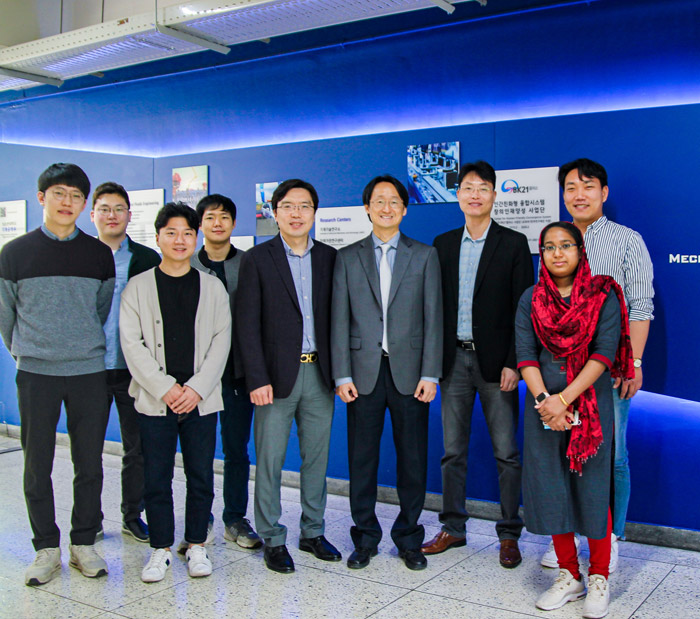
Mechanical Engineering BAIK, SEUNGHYUN Prof. ·Prof. Hyungpil Moon, and Prof. Moon Ki Kim
Develops Highly Conductive Healable Nanocomposite Materials
Prof. Seunghyun Baik, Prof. Hyungpil Moon, and Prof. Moon Ki Kim from SKKU’s School of Mechanical Engineering made a research report about the highly conductive completely reversible electron tunneling-assisted percolation network of silver nanosatellite particles for putty-like moldable and healable nanocomposites. Prof. Daewoo Suh (School of Mechanicl Engineering) and Prof. K. P. Faseela (Dept. of Energy Science) are co-first authors on the report. □ Deformable and healable conductive materials have received considerable attention due to their use in emerging future electronics, such as artificial human skin, internet of things, and bioelectronics, owing to their ability to recover from mechanical/electrical damage. However, their practical applications have been impeded by low electrical conductivity and irreversible conductivity degradation after breaking/healing cycles. □ The research team’s report is about the development of a highly conductive completely reversible electron tunneling-assisted percolation network of silver nanosatellite particles for putty-like moldable and healable nanocomposites. The densely and uniformly distributed silver nanosatellite particles with a bimodal size distribution are generated by the radical and reactive oxygen species-mediated vigorous etching and reduction reaction of silver flakes using tetrahydrofuran peroxide in a silicon rubber matrix. The close work function match between silicone and silver enables electron tunneling between nanosatellite particles, achieving high electrical conductivity and ~100% electrical healing efficiency. □ As an application demonstration, the highly conductive putty-like nanocomposites are employed as random-shaped electrical interconnectors, stably operating light-emitting diodes. An emergency electronics repair demonstration was also performed by a robot using the team’s nanocomposites. □ The research was published in Nature Communications. Daewoo Suh, K. P. Faseela, Wonjoon Kim, Chanyong Park, Jang Gyun Lim, Sungwon Seo, Moon Ki Kim, Hyungpil Moon, Seunghyun Baik, Electron tunneling of hierarchically structured silver nanosatellite particles for highly conductive healable nanocomposites, Nature Communications, 11, 2252 (May 2020), https://doi.org/10.1038/s41467-020-15709-8 Hierarchically structured silver nanosatellite particles for the highly conductive, moldable, healable, and stable nanocomposites.
- No. 136
- 2020-06-01
- 3850
-
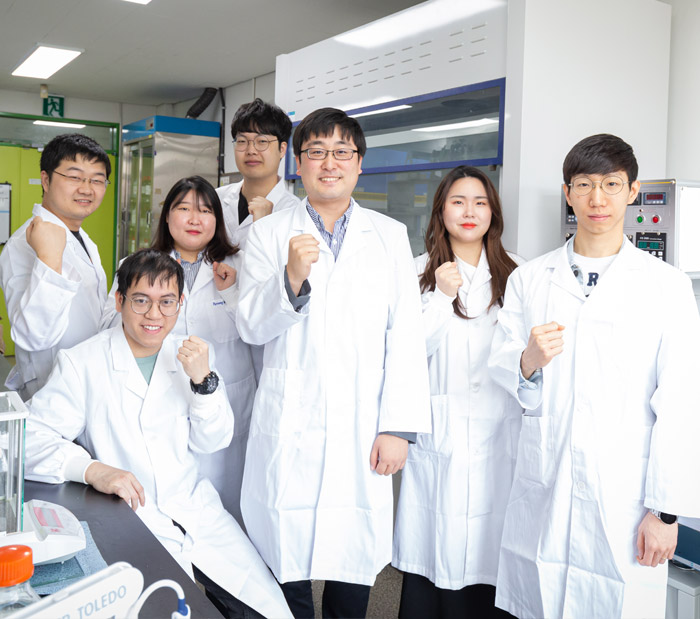
Chemical Engineering KIM, JUNG KYU Prof. ·Byong Wan Lee(SKKU postgraduate)
Prof. Kim Introduces Highly Efficient Solar-Hydrogen Energy Technology with the Plasmonic Patterned Structure of Au NSS
Prof. Jung Kyu Kim (School of Chemical Engineering) reported his research achievement: development of a novel transfer-printing of highly ordered Au nanosphere array to enhance light absorptance, charge transport and charge transfer performance of metal oxide films and their application for the photoanode of photoelectrochemical solar water splitting with high efficiency. N‐type metal oxides such as hematite (α‐Fe2O3) and bismuth vanadate (BiVO4) are promising candidate materials for efficient photoelectrochemical water splitting; however, their short minority carrier diffusion length and restricted carrier lifetime result in undesired rapid charge recombination. Herein, a 2D arranged globular Au nanosphere (NS) monolayer array with a highly ordered hexagonal hole pattern (hereafter, Au array) is introduced onto the surface of photoanodes comprised of metal oxide films via a facile drying and transfer‐printing process. Through plasmon‐induced resonance energy transfer, the Au array provides a strong electromagnetic field in the near‐surface area of the metal oxide film. The near‐field coupling interaction and amplification of the electromagnetic field suppress the charge recombination with long‐lived photogenerated holes and simultaneously enhance the light harvesting and charge transfer efficiencies. Consequently, an over 3.3‐fold higher photocurrent density at 1.23 V versus reversible hydrogen electrode (RHE) is achieved for the Au array/α‐Fe2O3. Furthermore, the high versatility of this transfer printing of Au arrays is demonstrated by introducing it on the molybdenum‐doped BiVO4 film, resulting in 1.5‐fold higher photocurrent density at 1.23 V versus RHE. The tailored metal film design can provide a potential strategy for the versatile application in various light‐mediated energy conversion and optoelectronic devices. This research outcome was published on 24th, April, 2020 in ‘Advanced Energy Materials’ (IF: 24.88), a world-renowned scientific journal. *Original Article: Retarded Charge–Carrier Recombination in Photoelectrochemical Cells from Plasmon‐Induced Resonance Energy Transfer, Advanced Energy Materials, https://onlinelibrary.wiley.com/doi/full/10.1002/aenm.202000570 *The researchers : Byoung Wan Lee (First Author, SKKU postgraduate), Jung Kyu Kim (Corresponding Author, Professor, School of Chemical Engineering)
- No. 135
- 2020-05-19
- 3689
-

Biomedical Engineering WOO, CHOONG-WAN Prof. ·Lada Kohoutová Researcher
Opening a black box: Interpretation of machine learning models in neuroimaging
□ Neuroimaging allows us to gain huge amount of data of the brain structure and function, and these data need to be processed with sophisticated methods. Machine learning has gained a large popularity in this field as a tool with which it is possible to create computational models of the brain function related to behaviour or cognitive stimuli. However, these models are complex and often an unreadable “black box” to humans. A computational model of the brain, in which we cannot explain why and how it works, only hardly contributes to the neuroscientific knowledge or clinical practice. Itis, thus, necessary to develop interpretation methods of such models. □ In the Cocoan lab (https://cocoanlab.github.io) lead by Choong-Wan Woo (Center for Neuroscience Imaging Research, Institute for Basic Science, Department of Biomedical Engineering, Sungkyunkwan University in South Korea), Lada Kohoutová (PhD student) and colleagues developed a framework of model interpretation and on its basis, they assembled a protocol according to which it is possible to easily assess and interpret a model from the aspect of its behaviour, significant features and in the context of biology (Fig. 1). Individual steps of their analysis pipeline yield a number of component results that together create an interpretable picture of a model. They introduced the framework along with the protocol in an article published in the journal, Nature Protocols. □ Prof. Choong-Wan Woo, who led the study, said, "Machine learning and the use of artificial intelligence are becoming more and more popular and common in various fields of neuroimaging, and thus the need for interpreting and explaining neuroimaging-based machine learning models is rapidly increasing,” and added, "This study will help develop neuroimaging-based predictive models that can be explained and trusted, and further promote a deeper understanding of brain mechanisms and its disorders” □ Lada Kohoutová, the first author also said, “Methods and procedures of interpreting machine-learning models in neuroimaging are not yet well-established and unified. Our protocol aims to establish a basis for a unified approach to model interpretation, open this black box a little, and so contribute to a deeper understanding of the brain and its function.” □ This work was supported mainly by Institute for Basic Science (IBS-IBS-R015-D1), National Research Foundation (2019R1C1C1004512), Ministry of Science and ICT (18-BR-03 and 2019-0-01367-BabyMind). □ This work is published in Nature Protorcols (IF 11.334) on March 18, 2020. ※ For video abstract, please visit https://youtu.be/kcDfEkoQa7Y
- No. 134
- 2020-04-27
- 4305
-

Mechanical Engineering KIM, TAESUNG Prof. ·Dr. KIM, Hyeong-U
Metallic 1T, Using Plasma-enhanced Chemical Vapor Deposition (PECVD), Film Synthesis Technique Developed
School of Mechanical Engineering/SAINT Prof. Kim, Taesung‧ Dr. Kim, Hyeong-U Development of New Method for Synthesis of Stable 1T-WS2 using PE-CVD Prof. Taesung Kim in Mechanical Engineering/SAINT and Dr. Hyeong-U Kim in SAINT have developed the synthesis technique of various 2-dimensional (2D) material using plasma-enhanced chemical vapor deposition (PECVD). A related research paper, ‘Wafer-scale of 1T-WS2 film for efficient and stable hydrogen evolution reaction.’ was published and featured on the back cover of ‘Small’ (IF: 10.85, JCR <10%). Professor Kim’s group reported the synthesis of large-scale MoS2 which is one of the typical transition metal dichalcogenides (TMDs) using PECVD at low temperature (<150 oC) for the first time in the world (Advanced Materials, 2015). Furthermore, a metal oxide group, α-MoO3 (Nanotechnology, 2017) and MoS2-Graphene heterostructure (Applied Surface Science, 2019) were synthesized for various applications. As 1T-phase WS2 (1T-WS2) typically has meta-stable structure with metallic properties, which can lead to excellent electrochemical catalytic properties as alternative materials for platinum, Prof. Taesung Kim group and Prof. Jae-Hyun Lee (Ajou University) group worked for the synthesis of stable 1T-WS2 with nano grain size for application of hydrogen evolution reaction (HER). The plasma can generate a nano grain size of 1T-WS2 with high surface energy so it can be stable in atmospheric pressure and room temperature. It was stable with 1,000 cycles and 1 month of exposure in the air for HER. Professor Kim mentioned that PECVD enables the wafer-scale synthesis of stable 1T-WS2 with high uniformity at low temperature (<150 oC) and this can be one of the critical technologies for future Hydron energy industry. (Currently, Dr. Hyeong-U Kim continues his research career at Northwestern University under the guidance of Professor Mark C. Hersam working on the synthesis of TMDs using MOCVD for memristor application.) ※ Related Papers 1) Low-Temperature Synthesis of Large-Scale Molybdenum Disulfide Thin Films Directly on a Plastic Substrate Using Plasma-Enhanced Chemical Vapor Deposition (Advanced Materials, 27, 2015, 5223-5229) (First Author: Dr. Chisung Ahn / Corresponding: Prof. Changgu Lee, Prof. Taesung Kim) 2) Highly uniform wafer-scale synthesis of α-MoO3 by plasma-enhanced chemical vapor deposition (Nanotechnology, 28, 2017, 175601) (First: Dr. Hyeong-U Kim / Corresponding: Prof. Taesung Kim) 3) Low-temperature wafer-scale growth of MoS2-graphene heterostructures (Applied Surface Science, 470, 2019, 129-134) (First: Dr. Hyeong-U Kim / Corresponding: Prof. Jae-Hyun Lee, Prof. Taesung Kim) 4) Wafer-Scale and Low-Temperature Growth of 1T-WS2 Film for Efficient and Stable Hydrogen Evolution Reaction (Small, 16, 2020, 1905000) (First: Dr. Hyeong-U Kim, Vinit Kanade, Mansu Kim / Corresponding: Prof. Jae-Hyun Lee, Prof. Taesung Kim) ○ Prof. Taesung Kim (Corresponding author), Dr. Hyeong-U Kim (1st author)
- No. 133
- 2020-04-14
- 3885
-

Energy Science YANG, HEEJUN Prof.
Quantum Mechanical Interlayer Interaction for Energy-Efficient 2d Vertical Transistors
Prof. Yang’s group (with Dr. Shoujun Zheng) recently reported the development of a new conceptual tunneling transistor based on resonant tunneling and the Stark effect in 2D heterostructures, which can operate with 100 times less energy consumption in comparison to conventional silicon devices. Recently, vertical tunneling transistors have demonstrated smaller subthreshold swing (SS) than silicon-based transistors. The 60 meV SS value of silicon devices has been considered the ultimate limit for transistors. However, inevitable thermal energy and non-resonant tunneling phenomena have prevented the development of practical tunneling transistors based on 2D materials. Prof. Yang’s research showed that the quantum mechanical Stark effect could resolve the issue in atomically thin tunneling transistors. The Stark effect was discovered in 1914, and as a result Johannes Stark was awarded the Nobel Prize in Physics in 1919. However, there has been no experimental verification of this effect at the device scale. In Prof. Yang’s study, the Stark effect was first observed at the device scale. Moreover, traditional phonons or excitons could be completely removed in transistor operation, which enabled a precise design of the tunneling transistors with a resolution of 0.01 eV. Prof. Yang mentioned that the tunneling transistor would be able to replace the key element in semiconductor technology, the field-effect transistor. This research was published in Advanced Materials (IF=25.809) on February 6, 2020. [Image] Resonant tunneling transistor based on 2Dmaterials and the corresponding band alignment of the materials
- No. 132
- 2020-03-27
- 3469
-
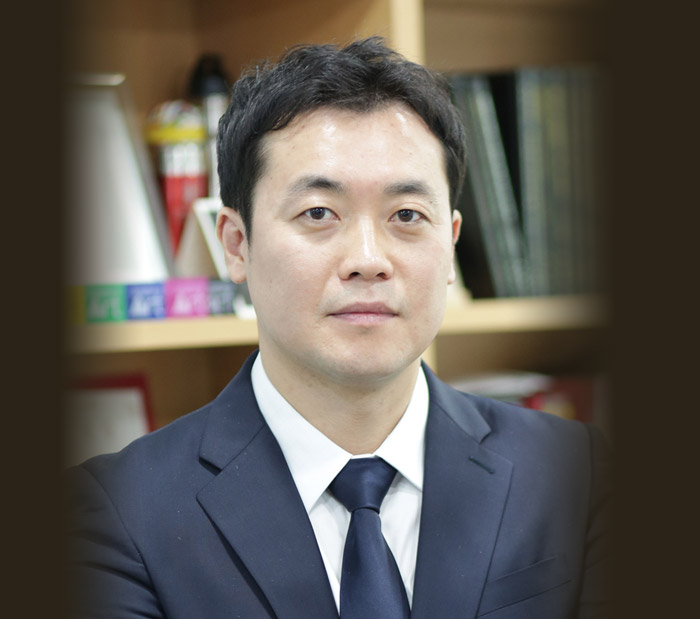
Chemical Engineering PANG, CHANGHYUN Prof. ·천성우 박사
Development of Triboelectric Energy Device Technology to Efficiently Harvest Horizontal Force-Based Energy
Despite the high-performance energy generation capabilities of previously reported triboelectric generator (TENG) devices, sensitive and efficient energy harvesting under contact/noncontact horizontal forces induced by in-plane stimuli is highly desirable for realizing portable and wearable electronics. Prof. Changhyun Pang in the Department of Chemical Engineering at Sungkyunkwan University (SKKU) reported on the versatile strategy for harvesting in-plane stimuli in TENG devices. A related research paper was published on the cover of Advanced Materials (Impact Factor 25.809). For wearable device applications that can be incorporated into cloth fabrics, accessories (watches, eyeglasses, etc.), and human skin, the power source is a crucial issue for long-term sustainable operation. The periodic recharging and exchanging of primary batteries causes maintenance time and costs. In this reason, Energy harvesting technology is considered an alternative solution to the power supply issue. In particular, a nanogenerator based on the triboelectric effect of two separated layers has been proven to be effective in utilizing irregular mechanical energy that is abandoned in everyday life. The architecture of a triboelectric nanogenerator (TENG) is mostly responsive to vertical pressure that leads to the contact of two separated layers. However, the efficient and sensitive generation of energy is not limited to the vertical direction. For example, in human body motion, friction as an energy generation source is mostly caused by a horizontal rubbing motion. So far, there has not been a pragmatic strategy to harvest the motion energy from various directions. The Pang’s team suggested a versatile strategy for TENG to transform in-plane kinetic energy into electricity. The assembled hairy-structures on the conventional TENG devices converts in-plane sliding motions into vertical vibration-like friction. This phenomena is due to momentary stress relief in transition between each of the pillars. Furthermore, the researchers also demonstrated that the microstructure is effective in capturing noncontact airflow due to the formation of dynamic vortices. This work showed an energy harvesting strategy that could be used for future wearable devices. Paper S. Chun, C. Pang, S. B. Cho, A Micropillar-Assisted Versatile Strategy for Highly Sensitive and Efficient Triboelectric Energy Generation under In-plane Stimuli, 32, 1905539, 2020.
- No. 131
- 2020-03-16
- 3471
-
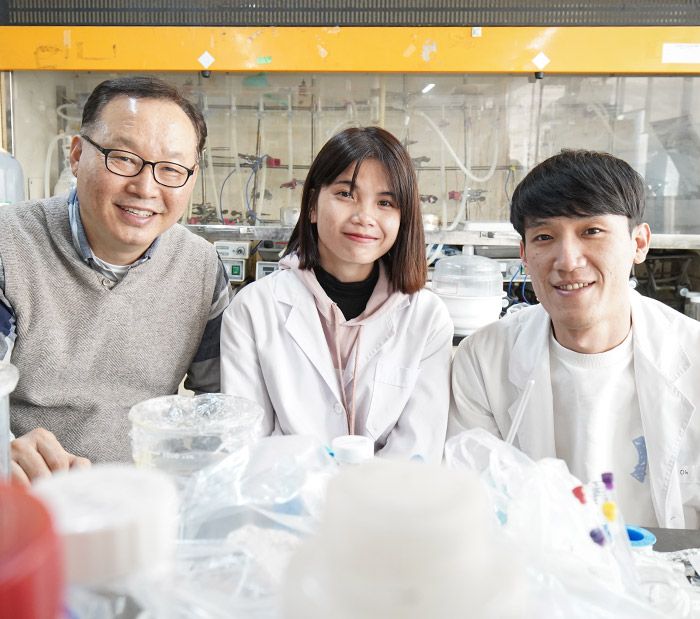
Chemistry LEE, HYOYOUNG Prof.
Addressing Global Warming with New Nanoparticles and Sunshine
Press Release www.ibs.re.kr For immediate release Publication Information - Paper Title: Highly Efficient Nanostructured Metal-decorated Hybrid Semiconductors for Solar Conversion of CO2 to Absolute CO Selectivity - Journal, Publication Date: Materials Today, January 3, 2020 - Authors: Chau T. K. Nguyen, Ngoc Quang Tran, Sohyeon Seo, Hee Min Hwang, Simgeon Oh, Jinsun Lee, Jianmin Yu, Thi Anh Le, Joseph Hwang, Meeree Kim, Hyoyoung Lee - DOI: 10.1016/j.mattod.2019.11.005 - Contact Regarding this Press Release: Professor Hyoyoung Lee (hyoyoung@skku.edu), Mr. Kyungyoon Min, Head of IBS Communications Team (+82-42-878-8156, kymin@ibs.re.kr); or Ms. Dahee Carol Kim, Public Information Officer of IBS & Science Communicator (+82-42-878-8133, clitie620@ibs.re.kr) Addressing Global Warming with new Nanoparticles and Sunshine Artificial photosynthesis:visible-light-driven photocatalysts convert CO2 into oxygen and pure CO under water Harvesting sunlight, researchers of the Center for Integrated Nanostructure Physics, within the Institute for Basic Science (IBS, South Korea) published in Materials Today a new strategy to transform carbon dioxide (CO2) into oxygen (O2) and pure carbon monoxide (CO) without side-products in water. This artificial photosynthesis method could bring new solutions to environmental pollution and global warming. While, in green plants, photosynthesis fixes CO2 into sugars, the artificial photosynthesis reported in this study can convert CO2 into oxygen and pure CO as output. The latter can then be employed for a broad range of applications in electronics, semiconductor, pharmaceutical, and chemical industries. The key is to find the right high-performance photocatalyst to help the photosynthesis take place by absorbing light, convert CO2, and ensuring an efficient flow of electrons, which is essential for the entire system. Titanium oxide (TiO2) is a well-known photocatalyst. It has already attracted significant attention in the fields of solar energy conversion and environmental protection due to its high reactivity, low toxicity, chemical stability, and low cost. While conventional TiO2 can absorb only UV light, the IBS research team reported previously two different types of blue-colored TiO2 (or “blue titania”) nanoparticles that could absorb visible light thanks to a reduced bandgap of about 2.7 eV.[LD1] They were made of ordered anatase/disordered rutile (Ao/Rd) TiO2 (called, HYL’s blue TiO2-I) [LH2] (Energy & Environmental Science, 2016), and disordered anatase/ordered rutile (Ad/Ro) TiO2 (called, HYL’s blue TiO2-II) [LH3] (ACS Applied Materials & Interfaces, 2019), where anatase and rutile refer to two crystalline forms of TiO2 and the introduction of irregularities (disorder) in the crystal enhances the absorption of visible and infra-red light. [LD4] Figure 1. Proposed energy diagram representing the electron transfer mechanism in TiO2/WO3-Ag hybrid nanoparticles. This so-called Z-scheme shows the flow of charged particles (electrons, e- and holes, h+) through the different components of the nanoparticles. Blue TiO2 and WO3’s e- can occupy lower (valence band, VB) and higher (conductive band, CB) energy levels. Photons from sunlight (thunders) provide the energy for the e- to jump up from the VB to the CB (black arrows pointing upwards), leaving h+ behind. TiO2’s lower band is close, just a bit lower than WO3’s higher band level, so e- from the high band of WO3 can migrate to the VB of blue TiO2 to trap its holes. After separation, the excited e- jump from the CB of TiO2 onto silver nanoparticles allowing the conversion of CO2 into CO, while the photogenerated h+ in the WO3 site oxidize water (H2O) to form oxygen (O2). For the efficient artificial photosynthesis for the conversion of CO2 into oxygen and pure CO, IBS researchers aimed to improve the performance of these nanoparticles by combining blue (Ao/Rd) TiO2 with other semiconductors and metals that can enhance water oxidation to oxygen, in parallel to CO2 reduction into CO only. The research team obtained the best results with hybrid nanoparticles made of blue titania, tungsten trioxide (WO3), and 1% silver (TiO2/WO3–Ag). WO3 was chosen because of the low valence band position with its narrow bandgap of 2.6 eV, high stability, and low cost. Silver was added because it enhances visible light absorption, by creating a collective oscillation of free electrons excited by light, and also gives high CO selectivity. The hybrid nanoparticles showed about 200 times higher performance than nanoparticles made of TiO2 alone and TiO2/WO3 without silver. Starting from water and CO2, this novel hybrid catalyst produced O2 and pure CO, without any side products, such as hydrogen gas (H2) and metane (CH4). The apparent quantum yield that is the ratio of several reacted electrons to the number of incident photons was 34.8 %, and the rate of reacted electrons 2333.44 μmol g−1h−1. The same measurement was lower for nanoparticles without silver (2053.2 μmol g−1h−1), and for nanoparticles with only blue TiO2 (912.4 μmol g−1h−1). “We expect these results will help the industry-scaled CO2 reduction and produce oxygen and commercially available CO derivatives,” says Hyoyoung Lee, CINAP associate director. Figure 2. Efficient and selective production of CO with different nanoparticles. (a) The graph shows that hybrid TiO2/WO3-Ag (7BT/W1-A1) nanoparticles are the best at selectively producing pure CO, without H2 and CH4 side products within a 7-hour timeframe. These can be compared with nanoparticles made of blue TiO2, WO3, hybrid TiO2/WO3 (7BT/W1) and hybrid TiO2/Ag (W1-A1). (b) CO production using different hybrid nanoparticles made of TiO2/WO3-Ag (red lines), TiO2/WO3 (green lines) and TiO2-only nanoparticles (blue lines) within 9 hours. 7BT/W1-A1 with a concentration of 1% silver has the best performance. Notes for editors - References Kan Zhang, Luyang Wang, Jung Kyu Kim, Ming Ma, Ganapathy Veerappan, Chang-Lyoul Lee, Ki-jeong Kong, Hyoyoung Lee* and Jong Hyeok Park*, “An order/disorder/water junction system for highly efficient co-catalyst-free photocatalytic hydrogen generation”, Energy & Environmental Science, Energy & Environmental Science, 2016, 9, 499-503. Hee Min Hwang, Simgeon Oh, Jae-Hyun Shim, Young-Min Kim, Ansoon Kim, Doyoung Kim, Joosung Kim, Sora Bak, Yunhee Cho, Viet Q. Bui, Thi Anh Le and Hyoyoung Lee. Phase-Selective Disordered Anatase/Ordered Rutile Interface System for Visible-Light-Driven, Metal-Free CO2 Reduction, ACS Applied Materials & Interfaces. (2019). DOI: 10.1021/acsami.9b10837 Chau T. K. Nguyen, Ngoc Quang Tran, Sohyeon Seo, Hee Min Hwang, Simgeon Oh, Jianmin Yu, Meeree Kim, Thi Anh Le, Jinsun Lee, Hyoyoung Lee. Phase-Selective Highly Efficient Nanostructured Metal-decorated Hybrid Semiconductors for Solar Conversion of CO2 to Absolute CO Selectivity, Materials Today. DOI: 10.1016/j.mattod.2019.11.005 - Media Contact For further information or to request media assistance, please contact Hyoyoung Lee (+82-031-299-4566, hyoyoung@skku.edu or Mr. Kyungyoon Min, Head of IBS Communications Team (+82-42-878-8156, kymin@ibs.re.kr); Ms. Dahee Carol Kim, Public Information Officer of IBS & Science Communicator (+82-42-878-8133, clitie620@ibs.re.kr) - About the Institute for Basic Science (IBS) IBS was founded in 2011 by the government of the Republic of Korea with the sole purpose of driving forward the development of basic science in South Korea. IBS has launched 30 research centers as of January 2020. There are ten physics, two mathematics, six chemistry, six life science, one earth science, and five interdisciplinary research centers.
- No. 130
- 2020-02-27
- 3741
-
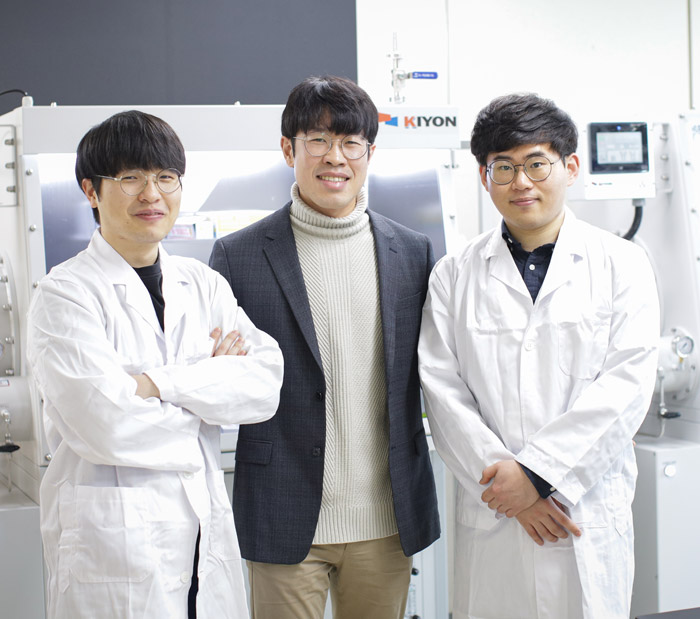
SKKU Advanced Institute of Nano Technology LEE, JIN WOOK Prof.
Resolving instability issues of perovskite solar cells and LEDs
Resolving instability issues of perovskite solar cells and LEDs Successful development of core technologies to impede ion migration pathways in perovskite solar cells and light-emitting diodes (LED) Prof. Jin-Wook Lee`s research team in the SKKU Advanced Nano Technology (SAINT) and Department of Nano Engineering have successfully developed core technologies to significantly improve the stability of perovskite solar cell and LED devices. The 3 research papers associated with it were published in Advanced Materials (impact factor=25.809), which is ranked within top 2% among the international SCI journals. Owing to the high efficiency comparable to silicon solar cells and organic LEDs, the perovskite solar cells and LEDs have been one of the strongest candidates for next-generation optoelectronic devices. However, operational stability of the devices was extremely poor compared to the commercialized devices. The high density of ionic defects in the low temperature solution processed perovskite thin films tends to easily migrate under built-in or applied electric field during the device operation, rupturing perovskite and adjacent charge transporting layers. This ion migration was a critical issue to improve the operational stability of the perovskite optoelectronic devices. Prof. Jin-Wook Lee`s research team developed core technologies to impede the ion migration pathways, resulting in significant improvement in operational stability of solar cell and LED devices. Using these techniques, the lifetime of the solar cell was improved more than 9-fold from 222 h to 2011 h (Advanced Materials, 2020, 1906995) while that of LED was improved more than 1000-fold from 12 min to over 200 h (Advanced Materials, 2020, 32, 1905674). Their technologies are expected to be a critical for commercialization of the perovskite optoelectronic properties by resolving the instability issue. Meanwhile, the research team also developed a new technology to improve the performance of perovskite quantum dot solar cells, which is regarded as a future technology to surpass the thermodynamic limit of the solar cell efficiency (Advanced Materials, 2019, 31, 1900111). ※ Related Journals 1) Steric Impediment of Ion Migration Contributes to Improved Operational Stability of Perovskite Solar Cells, Advanced Materials, 2020, 1906995. 2) Surface‐2D_Bulk‐3D Heterophased Perovskite Nanograins for Long‐Term‐Stable Light‐Emitting Diodes - Advanced Materials, 2020, 32, 1905674. - Wiley Online Library 3) A Small‐Molecule “Charge Driver” enables Perovskite Quantum Dot Solar Cells with Efficiency Approaching 13%, Advanced Materials, 2019, 31, 1900111.
- No. 129
- 2020-02-19
- 3512
-
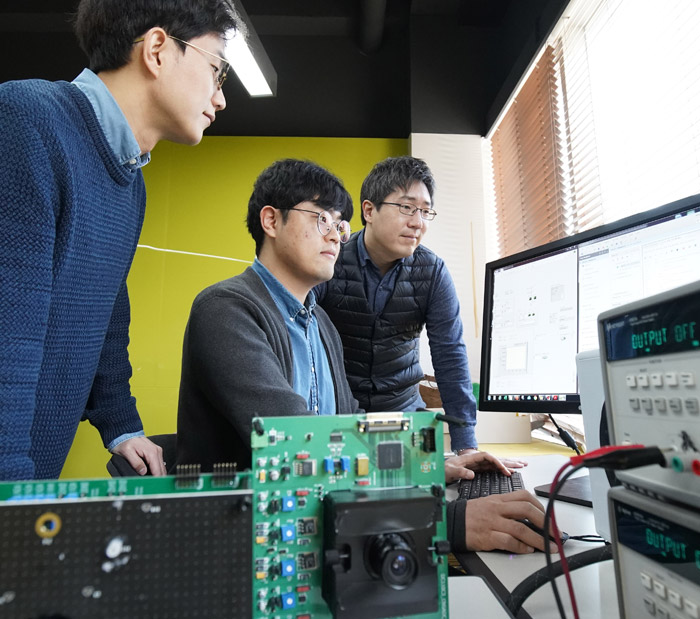
Semiconductor Systems Engineering CHOI, JAE HYUK Prof. ·전정훈 교수
Development of Time-of-Flight (ToF) 3D CMOS Image Sensor
Development of Time-of-Flight (ToF) 3D CMOS Image Sensor Prof. Jaehyuk Choi and Prof. Jung-Hoon Chun in the Department of Semiconductor Systems Engineering at SKKU have successfully developed a time-of-flight (ToF) 3D CMOS image sensor for mobile devices that generates 3-dimensional images of objects without motion artifact even under extreme illumination. The research paper was accepted to be published at the International Solid-State Circuits Conference (ISSCC), the top-tier conference on semiconductor circuits. Founded in 1954, ISSCC has a 66-year history this year and is the most prestigious conference called the Olympics in semiconductor circuitry. Each year, more than 3,000 scholars and engineers from 25 countries gather to showcase the world's best circuit technologies. It is also well known for selecting papers through a rigorous review process and for leading companies such as Intel and Samsung to present the latest technology competitively. The 3D image sensor that detects not only the shape of the object but also the distance information can be used for robot navigation and security applications as well as mobile applications such as 3D face recognition, distance-based autofocusing when taking pictures, and 3D image synthesis for augmented reality. The ToF image sensor is a sensor that detects the distance of an object by irradiating infrared light with high-frequency modulation and detecting a phase change of reflected light from the object. The ToF image sensor overcomes the size limitations of the conventional structured-light 3D image sensor used in existing mobile devices, and is a miniaturized sensor semiconductor with a fine distance-accuracy of mm. ToF image sensors have recently started to be installed in mobile devices, but the Japanese company (SONY) has preoccupied the market. Besides, there are technical problems such as limitations of depth resolution and image resolution, distortion in detecting moving objects, and saturation due to extreme illumination in outdoor imaging. SKKU's research team developed a ToF image sensor SoC that integrates a high-speed photodiode device that improves depth resolution, an upscaling image processor that outputs 320 x 240 pixels of physical pixels at 640 x 480 (VGA) resolution, a dynamic modulation circuit that reduces motion artifacts, and an ambient-light cancelling circuit. In collaboration with UNIST and domestic Fabless company ZeeAnn, our research team successfully developed prototype sensor chips and outperformed existing ToF sensors. The paper will be presented at the ISSCC's Imagers and ToF Sensors session in February 2020. A total of 10 papers accepted in the session are mainly published by the world's top companies such as Samsung, Sony, Toshiba and Panasonic, and SKKU is the only domestic university. In addition to paper presentation, SKKU's research team will demonstrate the performance of the ToF image sensor directly in the demonstration session of the ISSCC conference. ※Paper: “A Dynamic Pseudo 4-Tap CMOS Time-of-Flight Image Sensor with Motion Artifact Suppression and Background Light Cancelling Over 120klux”, ISSCC, 2020. ※Authors: Donguk Kim (1st author, dept. of electrical and computer engineering, SKKU), Jaehyuk Choi (corresponding author, dept. of semiconductor systems engineering, SKKU), Jung-Hoon Chun (co-author, dept. of semiconductor systems engineering, SKKU), Canxing Piao Park·Yeonsoo Ahn·Kihwan Cho (co-authors, dept. of electrical and computer engineering, SKKU), Seunghyun Lee·Dahwan Park·Seong-Jin Kim (co-authors, dept. of electrical and computer engineering, UNIST), Jungsoon Shin·Seung-Min Song (co-authors, ZeeAnn)
- No. 128
- 2020-01-28
- 3639
-
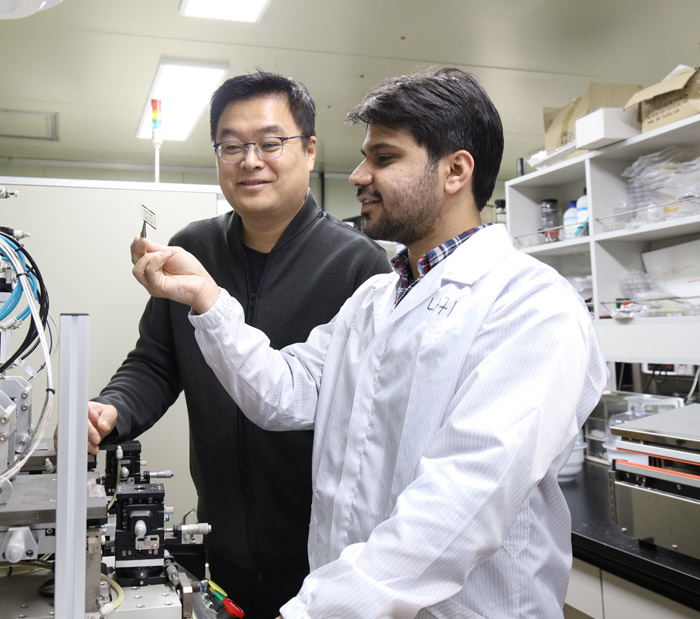
Advanced Materials Science and Engineering KIM, SUNKOOK Prof.
All-day Mobile Healthcare Monitoring System Based on Heterogeneous Stretchable Sensors for Medical Emergencies
All-day Mobile Healthcare Monitoring System Based on Heterogeneous Stretchable Sensors for Medical Emergencies Wearable mobile healthcare devices are among the most rapidly developed modern electronic technologies due to advances in novel flexible processes, ultrathin devices and sensors, and flexible/stretchable materials. Korean researchers at Sungkyunkwan University (SKKU) have developed a fully integrated wearable smart patch based sensor system with nature-inspired, and strain-free deformable structures that has temperature and humidity sensors for long-term wearable and medical emergency devices. The study appeared in the journal IEEE Transaction on Industrial Electronics Reports in November, 2019. In recent years, there have been growing interests in epidermal and wearable electronic sensor technologies due to their ability to deliver real-time healthcare information to personalized smartphones. A team of researchers led by Prof. Sunkook Kim, who have been working on this for more than five years, addressed the challenge of continuous and long-term monitoring of biological signals in the human body by introducing a well-equipped breathable, bio-compatible, and conformable smart patch that can absorb moisture (sweat) generated from the skin without any irritation. This allows the users to continuously monitor their health as well as to detect and diagnose issues early. Inspired by nature, the researchers reported a novel structured device that is comprised of 3D-deformable and 2D stretchable platforms for wearable mobile point-of-care healthcare diagnostics that is conformably attached to a person’s skin. It includes a platinum (Pt)-resistance thermometer, humidity sensor, a signal processing IC, a wireless communication module, and a long-life battery. Furthermore, the wearable device has a fall-down detection feature that consists of a 3-axis accelerometer sensor that is mounted on the device. Prof. Kim said, “We have established a fully integrated wearable sensor system that can easily attach to the skin accurately detecting body information with an integrated circuit that includes a read-out circuit. This enables wireless communication and information transfer (temperature, humidity, and motion) to mobile phones assisting with emergencies and medical checkups for vulnerable patients.” He further added, “The proposed smart patch based healthcare device allows numerous new opportunities in the wearable electronics and biomedical fields as well as in internet of things (IoT) applications.” [Reference] Lee. S. et al., (2019) “All-day Mobile Healthcare Monitoring System Based on Heterogeneous Stretchable Sensors for Medical Emergency” IEEE-TIE Reports [Main Author] Sunghoo Lee (Korea Electronics Technology Institute), Srinivas Gandla (Sungkyunkwan University), Muhammad Naqi (Sungkyunkwan University), and Uihyun Jung (Sungkyunkwan University). **For inquires regarding this project, please contact Professor Sunkook Kim at seonkuk@skku.edu.
- No. 127
- 2020-01-13
- 3903
